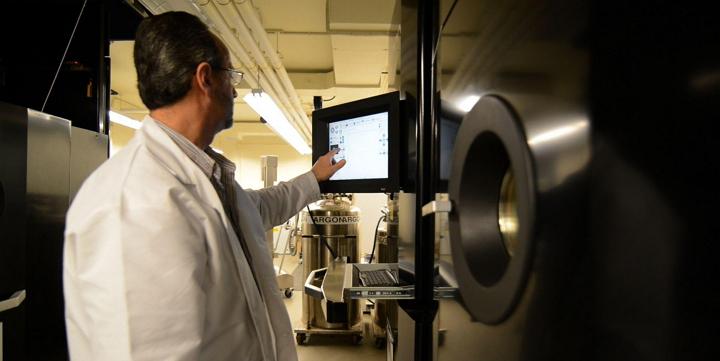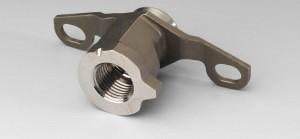 Pratt & Whitney has been working to develop 3D manufacturing techniques for 25 years, and up until recently that meant plastic parts used as prototypes or tooling and support for metal parts.
Pratt & Whitney has been working to develop 3D manufacturing techniques for 25 years, and up until recently that meant plastic parts used as prototypes or tooling and support for metal parts.
But that process has undergone a radical change as Pratt & Whitney prepares to deliver the first PurePower PW1500G engines to Bombardier. This latest engine will feature what are called “entry-into-service jet engine parts,” and they’re produced using additive manufacturing techniques and space-age metals.
 In the past, Pratt & Whitney has built more than 100,000 prototype parts using additive manufacturing – and hundreds more to support the PurePower Geared Turbofan engine development process – but this marks the first time additive manufacturing technology has been used to produce compressor stators and synch ring brackets for a production engine.
In the past, Pratt & Whitney has built more than 100,000 prototype parts using additive manufacturing – and hundreds more to support the PurePower Geared Turbofan engine development process – but this marks the first time additive manufacturing technology has been used to produce compressor stators and synch ring brackets for a production engine.
The project means dozens of parts produced using 3D manufacturing processes made from titanium and nickel have been flight-tested for use in Airbus and Bombardier aircraft entering passenger service in the second half of 2015.
The list of parts includes brackets, oil nozzles, fuel-bypass manifolds, mounts, fittings, and airfoils, and it’s the ability of additive manufacturing techniques to make parts of nearly any shape or geometry that makes it possible.
Tom Prete, Pratt & Whitney’s Engineering vice president, says his company’s work with additive manufacturing since the 1980s has made this milestone a reality.
“We are a vertically integrated additive manufacturing producer with our own metal powder source and the printers necessary to create parts using this innovative technology,” Prete says. “As a technology leader, we are intrigued by the potential of additive manufacturing to support our suite of technologies and benefits to customers and the global aerospace industry.”
 Pratt & Whitney has also built what’s known as a “borescope boss” for their PurePower PW1100G-JM engine using selective laser melting, or SLM. The low-pressure turbine for the PW1100G-JM geared turbofan (GTF) engine will be equipped with borescope bosses allows the turbine case and blading to be inspected for wear and damage using a borescope.
Pratt & Whitney has also built what’s known as a “borescope boss” for their PurePower PW1100G-JM engine using selective laser melting, or SLM. The low-pressure turbine for the PW1100G-JM geared turbofan (GTF) engine will be equipped with borescope bosses allows the turbine case and blading to be inspected for wear and damage using a borescope.
Lynn Gambill, the chief engineer for Manufacturing Engineering and Global Services at Pratt & Whitney, says that during production tests, the company has realized up to a 15 month lead-time savings and up to 50 percent weight reduction in a single part when compared to parts made with conventional manufacturing processes.
The PurePower engine production process includes components made with Metal Injection Molding, Electron Beam Melt, and Laser Powder Bed Fusion, which includes Direct Metal Laser Sintering techniques.
Much of the development work goes on at the Pratt & Whitney and the University of Connecticut Additive Manufacturing Innovation Center. Pratt & Whitney is a United Technologies company.
Do you know of any other uses of 3D printing in aerospace applications? Let us know in the Pratt & Whitney Jet Engines forum thread on 3DPB.com.
Subscribe to Our Email Newsletter
Stay up-to-date on all the latest news from the 3D printing industry and receive information and offers from third party vendors.
You May Also Like
Industrial Giant Ingersoll Rand Leads $19M Round Backing Inkbit’s AI-Driven 3D Printing
Inkbit, the Massachusetts-based original equipment manufacturer (OEM) of multi-material, AI-integrated 3D printers, has closed a $19 million financing round. Ingersoll Rand, a US giant in the industrial equipment sector, led...
3D Printing Unpeeled: Digital FDM Filament for Functional Gradients
Just published in Nature, a paper by a Seoul National University team looks at “3D printing with a 3D printed digital material filament for programming functional gradients.” Sang-Joon Ahn, Howon...
3D Printing Unpeeled: $5000 Cold Spray 3D Printer, Roland DGA & Living Materials
The AeroForge is a $5000 cold spray metal printer for copper made by a student team at Rice University. In a paper for ACS Central Science a team from Nanjing...
3D Printing News Briefs, April 27, 2024: Research, Digital Dentistry, Cycling, & More
We’re starting today’s 3D Printing News Briefs with some research into 3D printed luminescent quantum-dot polymer architectures and free-form laser beam shaping, and then on to an open source 4-axis...

































